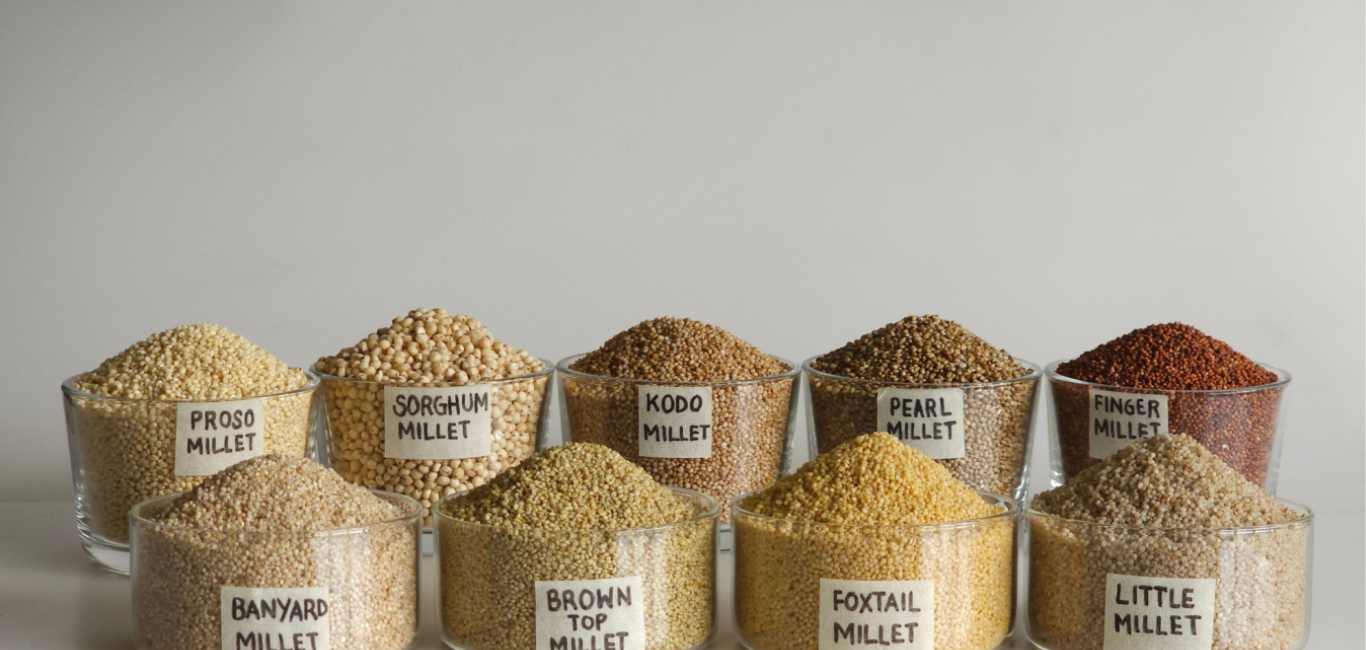

Different Types of Millets and Their Nutritional Benefits
Introduction to Millets
Millets, small-seeded grasses, have been staple foods in various parts of the world for centuries. Known for their resilience and adaptability, these ancient grains are primarily cultivated in India and Nigeria. Their ability to thrive in less fertile soil and semi-arid regions makes them a crucial crop for sustainable agriculture. Millets can withstand a wide range of climatic conditions in India, from droughts to high temperatures, making them eco-friendly and sustainable.
One of the key attributes of millets is their gluten-free nature. This quality makes them an excellent alternative for individuals with gluten intolerance or celiac disease, offering a nutritious substitute to traditional gluten-containing grains like wheat, barley, and rye.
Different Types of Millets
Millets come in various types, each with unique nutritional benefits and regional names. Here is an overview of some popular types of millets:
Finger Millet (Ragi)
Finger millet, known as Ragi in India, is renowned for its high calcium and fiber content. This makes it particularly beneficial for bone health and digestion. Rich in essential amino acids, finger millet is a valuable protein source, supporting muscle growth and repair. Additionally, its high iron content helps combat anemia and boosts overall energy levels.
Foxtail Millet (Kakum/Kangni)
Foxtail millet, also known as Kakum or Kangni, is a gluten-free grain rich in antioxidants and dietary fiber. Its low glycemic index makes it an excellent choice for managing diabetes. The antioxidants present in foxtail millet help reduce oxidative stress and inflammation, contributing to heart health. Its high fiber content aids in digestion and weight management.
Sorghum Millet (Jowar)
Sorghum, commonly referred to as Jowar, is packed with antioxidants and dietary fiber. These properties support immune function, improve bone health, and promote overall well-being. Sorghum is also rich in essential minerals like iron, phosphorus, and magnesium, which are vital for maintaining healthy bodily functions.
Proso Millet (Chena/Barri)
Proso millet, known as Chena or Barri, stands out for its high protein content and B vitamins. These nutrients are crucial for muscle development, energy production, and cognitive function. Proso millet's low glycemic index makes it a suitable choice for individuals managing blood sugar levels.
Pearl Millet (Bajra)
Pearl millet, or Bajra, is an energy-packed grain rich in iron and dietary fiber. Its high iron content supports blood health by preventing anemia, while the fiber aids in digestion. Pearl millet is also a good source of essential fatty acids, which contribute to heart health.
Brown Top Millet (Korle)
Brown top millet, known as Korle, is valued for its high fiber content, which promotes digestive health and aids in weight management. Its nutrient profile includes essential vitamins and minerals that support overall well-being.
Barnyard Millet (Sanwa)
Barnyard millet, or Sanwa, is a low-calorie grain with a high fiber content, making it suitable for weight control and digestive health. Its rich nutrient profile includes vitamins and minerals that support various bodily functions.
Little Millet (Moraiyo)
Little millet, known as Moraiyo, is rich in B vitamins and dietary fiber. These nutrients support energy levels, improve digestion, and help manage blood sugar levels. Little millet is also a good source of antioxidants, which help combat oxidative stress.
Kodo Millet (Kodra/Varagu)
Kodo millet, also known as Kodra or Varagu, is high in fiber and antioxidants. These properties support digestive health and overall well-being. Kodo millet's nutrient profile includes essential vitamins and minerals that contribute to healthy bodily functions.
Buckwheat Millet (Kuttu)
Buckwheat, often referred to as Kuttu, is not a true millet but is often included in the millet family due to its similar nutritional benefits. It is rich in nutrients that support heart health and has a robust nutrient profile, including fiber, protein, and essential vitamins and minerals.
Nutritional Value of Millets
Millets are rich sources of proteins, dietary fiber, vitamins, and minerals. They are particularly high in B vitamins, including niacin, B6, and folic acid, which are essential for energy production and overall health. Millets also provide a wealth of essential minerals like phosphorus, magnesium, and iron.
Unique antioxidants found in millets help combat oxidative stress and reduce inflammation, which is beneficial for preventing chronic diseases. Millets have a low glycemic index, making them suitable for individuals with diabetes as they help in managing blood sugar levels effectively. Additionally, millets provide essential fatty acids and are a good source of calcium, potassium, and other nutrients that support various bodily functions.
Health Benefits of Millets
Digestive Health
Millets contribute significantly to digestive health due to their high fiber content. They contain prebiotics, which promote the growth of beneficial gut bacteria. This helps improve digestion, prevents constipation, and reduces the risk of developing digestive disorders.
Heart Health
Millets support heart health through their high magnesium content and the presence of antioxidants. Magnesium helps regulate heart rhythm and supports muscle function. Additionally, millets contain adiponectin, a protein hormone that has anti-inflammatory properties and can reduce the risk of heart disease.
Weight Management
Millets are low in calories yet high in fiber and protein, making them an excellent choice for weight management. The high fiber content keeps you feeling full for longer, reducing overall calorie intake. Protein supports muscle mass and boosts metabolism, further aiding in weight control.
Mood Enhancement
Millets are rich in tryptophan, an amino acid that plays a role in mood regulation. Tryptophan is a precursor to serotonin, a neurotransmitter that helps improve mood and reduce symptoms of depression and anxiety.
Versatility in Usage
Millets are incredibly versatile and can be incorporated into various dishes. They can be used in breakfast cereals, porridge, stews, soups, and salads. Their mild flavor makes them an excellent base for a wide range of recipes, allowing for creative culinary applications.
Incorporating Millets into Diets
Here are some tips for incorporating millets into your daily diet to enjoy their diverse nutritional benefits:
- Porridge: Start your day with a warm bowl of millet porridge. Add fruits, nuts, and a drizzle of honey for added flavor and nutrition.
- Salads: Use cooked millets as a base for hearty salads. Combine with fresh vegetables, herbs, and a light dressing for a nutritious meal.
- Rice Alternative: Substitute millet for rice in your favorite dishes. It can be used in pilafs, stir-fries, and as a side dish.
- Baking: Incorporate millet flour into your baking recipes. It can be used in bread, muffins, and pancakes for added nutrition.
- Snacks: Make millet-based snacks like energy bars, cookies, or puffed millet snacks for a healthy, on-the-go option.
Combining millets with a variety of fruits, vegetables, and proteins can help create a balanced diet, ensuring you receive a wide range of nutrients.
Frequently Asked Questions about Millets
What are millets?
Millets are small-seeded grasses that serve as staple foods in many parts of the world. They are known for their resilience, nutritional benefits, and gluten-free nature.
Are millets gluten-free?
Yes, millets are naturally gluten-free, making them an excellent choice for individuals with gluten intolerance or celiac disease.
What health conditions can millets help with?
Millets can aid in managing various health conditions, including diabetes, heart disease, digestive disorders, and weight management. They are also beneficial for improving bone health and boosting overall immunity.
How much millet should I consume daily?
There is no specific recommended daily intake for millets, but including them regularly in your diet can offer significant health benefits. Consult with a healthcare professional for personalized dietary advice.
Can millets help with weight management?
Yes, millets are low in calories and high in fiber and protein, making them effective for weight management. They help keep you full for longer, reducing overall calorie intake.
Are millets suitable for diabetics?
Millets have a low glycemic index, making them suitable for individuals with diabetes. They help manage blood sugar levels and provide sustained energy.
How do millets support digestive health?
Millets are high in dietary fiber, which promotes healthy digestion and prevents constipation. They also contain prebiotics that support the growth of beneficial gut bacteria.
Conclusion
Incorporating different types of millets into your diet can provide numerous health benefits and contribute to sustainable eating habits. Millets are rich in essential nutrients, including proteins, dietary fiber, vitamins, and minerals. They support various aspects of health, from digestion and heart health to weight management and mood enhancement.
The versatility of millets makes them easy to incorporate into a wide range of dishes, from breakfast cereals and porridges to salads and baked goods. By including millets in your diet, you can enjoy their unique nutritional benefits while contributing to a more sustainable and health-conscious way of eating.
